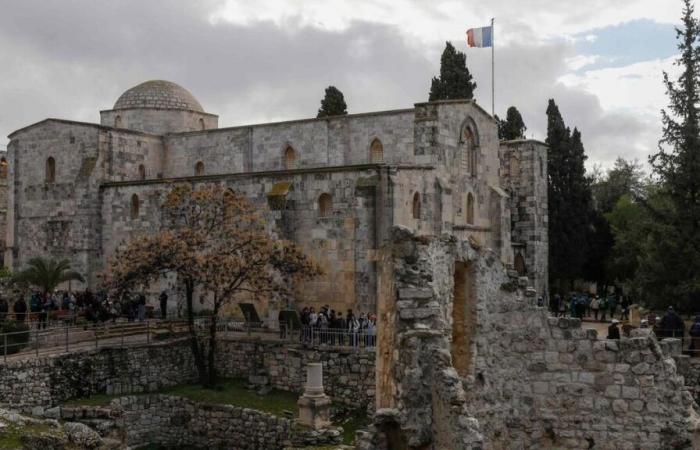
“An unacceptable situation. » The head of French diplomacy, Jean-Noël Barrot, traveling to Jerusalem did not mince his words after an incident that occurred on the sidelines of his planned visit to Eléona on Thursday. Israeli security forces entered there “armed, without first obtaining authorization from France and without agreeing to leave,” he asserts.
Two French gendarmes who provided security for the Minister of Foreign Affairs were briefly arrested inside the site, which is nevertheless part of French national domain.
France is the only foreign power to own four so-called “national domains” sites in Jerusalem, the fruit of a long historical heritage. In addition to the Eléona site, which the Israeli police entered on Thursday, there are the Tomb of the Kings, the domain of Saint-Anne and the monastery of Abu Gosh.
The Eleona
Property of France since the 19th century, the Eléona national domain is located on the Mount of Olives in East Jerusalem, the Palestinian part of the city occupied and annexed by Israel since 1967.
The site was built on the so-called “Pater” cave, where Christ, according to Christian tradition, taught the “Our Father” prayer (our fatherin Latin) to his disciples. A basilica, now in ruins, was built there by Helena, the mother of Emperor Constantine, in the 4th century.
Long prohibited from access to Christians, the estate was bought in 1856 by Aurélie de la Tour d'Auvergne who had a cloister built above the cave by Viollet-le-Duc. She donated it to France in 1874. Carmelites have lived there since 1873 under French diplomatic protection. Enjoying an exceptional view of the Old Town, the area attracts many tourists and pilgrims.
The Tomb of the Kings
Long wrongly considered the tomb of the kings of Judea, the Tomb of the Kings more probably corresponds to the mausoleum of Helen of Adiabene, a Jewish queen of the 1st century buried with around thirty notables. The underground site, also located in the disputed area of East Jerusalem, is accessible by a monumental staircase carved into the stone which descends to a vast cave where there are several sarcophagi, some of which were transported to the Louvre.
Excavated in 1863 by French archaeologists, the Tomb was purchased by the Péreire brothers, French Jewish bankers, who ceded it to France in 1886 to “preserve it for the science and veneration of the faithful children of Israel”.
Ultra-Orthodox Jews still contest this property right. They meet regularly in front of the gate to obtain the right to enter and pray at this revered site. The place reopened in 2019 after ten years of work financed by France.
Sainte-Anne church
Located in the Old City of Jerusalem, Saint Anne's Church is a stone's throw from Saint Stephen's Gate, also called Lions' Gate. The original building, in Romanesque style, was built by the Crusaders in the 12th century on the supposed site of the house of the parents of the Virgin (whose mother was called Anne), right next to the Bethesda swimming pool, where according to Gospels, Christ heals a paralyzed man.
Transformed into a Koranic school after the fall of the Latin Kingdom of Jerusalem in 1291, it was offered to France in 1856 by the Ottoman sultan to thank Napoleon III for his intervention against the Russians during the Crimean War.
It has been managed since 1878 by the “White Fathers”, a community of missionary priests in the Maghreb and sub-Saharan Africa, responsible for dialogue with the Eastern Churches present in Jerusalem.
In 2020, Emmanuel Macron ordered Israeli police officers to leave the area after they attacked French law enforcement officers. The most famous incident remains that of 1996, when Jacques Chirac lost his temper against Israeli soldiers who were surrounding him too closely, before demanding their expulsion from the area.
Abu Gosh Monastery
Located about ten kilometers west of Jerusalem in an Israeli Muslim village, the Abu Gosh monastery has been home to Benedictine monks and nuns since 1976. This former commandery was built in the 12th century by the Order of Hospitallers for the pilgrims who stopped there before going up to Jerusalem. The monastery also has a Romanesque chapel decorated with superb Byzantine frescoes.
It was given to France by Sultan Abdulaziz in 1873 to compensate for the capture of St. George's Church in Lydda by the Orthodox Greeks.





